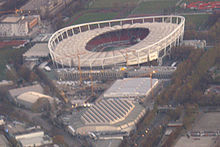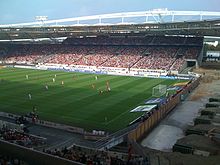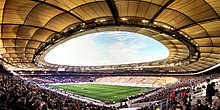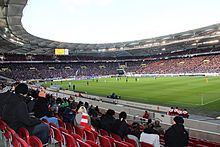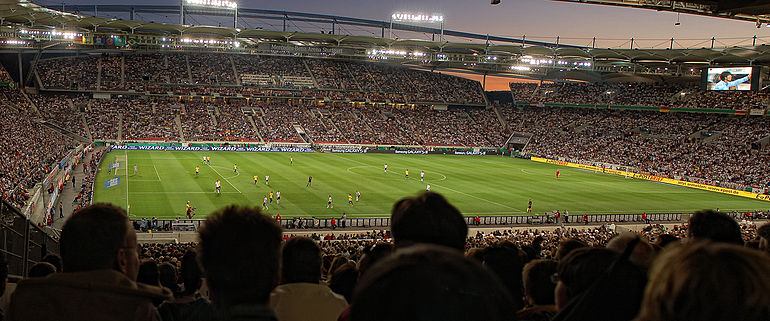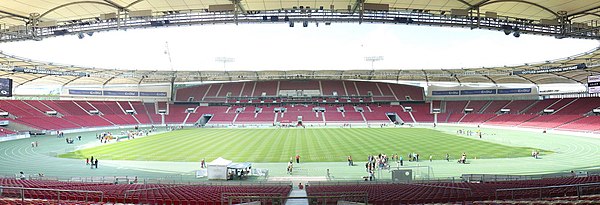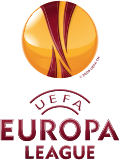Mercedes-Benz Arena (Stuttgart)
| Mercedes-Benz Arena | |
|---|---|
| Neckar Stadium | |

|
|

|
|
| View from Rotenberg to the Mercedes-Benz Arena shortly before its completion in June 2011 | |
| Earlier names | |
|
|
| Sponsor name (s) | |
|
|
| Data | |
| place |
|
| Coordinates | 48 ° 47 '32 " N , 9 ° 13' 55" E |
| classification | 4th |
| owner | Stadium NeckarPark GmbH & Co. KG |
| operator | VfB Stuttgart Arena Betriebs GmbH |
| opening | July 23, 1933 |
| Renovations | 1949-1951 |
| Extensions | 1935 1955–1956 1971–1973 1993 2001 2004–2005 2009–2011 |
| surface | Natural grass |
| costs | 2.35 million RM (first construction 1929–1933) 27.3 million € (conversion 1993) 51.25 million € (conversion 2001 / 2004–2005) 62.928 million € (conversion 2009–2011) |
| architect | 1933: Paul Bonatz 1971–1973: Siegel, Wonneberg & Partner 1993: Schlaich, Bergermann and Partner 2001 / 2004–2005: Gottlieb-Daimler-Stadion planning association 2009–2011: 'asp' Architects Stuttgart |
| capacity | 60,449 seats |
| Capacity (internat.) | 54,812 seats |
| playing area | 105 m × 68 m |
| Societies) | |
| Events | |
|
Soccer :
Athletics :
Miscellaneous :
|
|
The Mercedes-Benz Arena , in parlance often Neckarstadion , is a football stadium in Neckarpark in the Stuttgart district of Bad Cannstatt . It was completed in 1933, since then it has been rebuilt and expanded several times and today offers space for 60,449 spectators. Over time, the name of the stadium changed several times.
The Mercedes-Benz Arena is the home stadium of the Bundesliga team of VfB Stuttgart . The owner is the Stadion NeckarPark GmbH & Co. KG, in which the city of Stuttgart holds 60 percent and VfB Stuttgart 40 percent.
Location of the stadium
The Mercedes-Benz Arena is the heart of the Neckar Park. Directly on the north side of the arena is the Carl Benz Center , an elongated adventure center for soccer fans with the Carl Benz Arena. The Porsche-Arena and Hanns-Martin-Schleyer-Halle follow immediately afterwards . South of the arena is the Mercedes-Benz World and the Daimler test track as well as the Festwiese stadium . The Mercedes-Benz Untertürkheim plant is located next to the Mercedes-Benz world . To the south-east of the stadium is the club area of VfB Stuttgart with training grounds, clubhouse and Robert-Schlienz-Stadium, and to the east is the house of sports "SpOrt". The Cannstatter Wasen is located about 250 meters west of the stadium .
history
1933–1973: construction, reconstruction and renaming
The stadium architects were Paul Bonatz and Friedrich Eugen Scholer . The stadium was built from 1929 to 1933 under the name of the Stuttgarter Kampfbahn for the 15th German Gymnastics Festival and was put into operation in 1933 under the name of Adolf-Hitler-Kampfbahn . Initially it held 35,000 spectators. By 1935 it was expanded to 70,000 places. In 1939 the boxing match between Max Schmeling and Adolf Heuser was held in the stadium in front of a record crowd of over 60,000 spectators, which is still valid for boxing events in Germany today .
After the war, the stadium was renamed Century Stadium and later the arena and used for baseball games by the US crew . In 1949 the stadium was renamed Neckarstadion . In the same year, in front of 92,000 spectators, the final, which went down in history as the " Heat Battle of Stuttgart ", for the German soccer championship between VfR Mannheim and Borussia Dortmund took place. In 1950, the first German post-war international match against Switzerland was played here in front of 103,000 spectators. An open opposite stand was built between 1949 and 1951. After the expansion, the stadium held 97,500 spectators.
On June 3, 1959, the final of the European Cup between Real Madrid and Stade Reims took place there in front of 80,000 spectators, and on September 5, 1962 one of the two finals in the European Cup Winners' Cup between Atlético Madrid and Fiorentina took place.
1974–1993: Large events and extensive renovations
The main stand was demolished for the 1974 World Cup and a new three-storey stand was built in its place. The opposite stand was roofed over and a display board was set up in the middle of the Untertürkheim curve. This was installed above the marathon goal, between the lower and upper tier. This placement of the board was chosen despite the omission of the seats behind it because, in contrast to a location at the very top, the substructure required due to its mass was present there and the view of it from the straight was not obstructed by the grandstand roof. The stadium now held 72,000 spectators, at international matches with increased, but space-consuming capacity for the press, almost 70,000 spectators, including almost 40,000 seats. During the tournament four games took place in the stadium: in the preliminary round the games Poland against Argentina (3: 2), Argentina against Italy (1: 1) and Poland against Italy (2: 1) as well as in the second round of Group B Poland against Sweden (1-0).
In 1976, after two years of preparation, the first open-air concert in a German football stadium took place in the Neckar Stadium, with the Rolling Stones and other bands performing. The promoters of this event were Jürgen Weber, Rainer Pörtner and Fritz Rau . In order to be able to prove to the city that the soccer turf does not suffer from the visitors, extensive reports had to be drawn up by the Agricultural University of Hohenheim . The entire field, including the tartan track, was covered with PVC kitchen flooring.
In 1986, instead of the old scoreboard, the arena was the first German stadium to have a full-matrix color video wall , which reduced the capacity to just under 70,000 spectators, as the larger width meant that there were no more standing room in the Untertürkheim curve. In the same year the stadium hosted the European Athletics Championships in 1986 . Despite the bad weather, a total of 300,000 spectators attended the events. For the organization of the European Championships the city of Stuttgart received the Olympic Cup of the IOC .
On May 25, 1988 the final of the European Cup between PSV Eindhoven and Benfica Lisbon took place there in front of 70,000 spectators.
During the European Football Championship in 1988 , the stadium was the venue for two games: the preliminary round match between England and Ireland (0: 1) and the semi-final match between Italy and the Soviet Union (0: 2).
On May 17, 1989, VfB Stuttgart played there in the second final of the UEFA Cup against SSC Napoli 3: 3. Stuttgart lost the first leg 2-1.
1993–2008: World Athletics Championships and the second World Cup
In 1990 underfloor heating was installed. For the athletics world championships in 1993 , the roofs of the main and opposite stands were torn down and replaced by the complete membrane roofing that still exists today. Most of the standing room has been converted to seating; as a result, capacity fell to 53,700 seats, 47,600 of which were seats. The World Athletics Championships were attended by a total of 585,000 spectators - the highest number of spectators ever achieved at the World Athletics Championships. For “the great interest of the audience, the expertise and enthusiasm of the audience”, the visitors to the world championships were awarded the UNESCO Fair Play Prize.
As part of the renovation for the World Athletics Championships, the stadium was given the name "Gottlieb Daimler Stadium". This was made through a resolution of the City Council of Stuttgart. The then automobile company Daimler-Benz financed the construction of a covered walkway at the neighboring Hanns-Martin-Schleyer-Halle for 10 million D-Marks , but the renaming of the stadium was done on a voluntary basis. Daimler-Benz initially refused to rename it because the group did not provide any conditions for financing the construction. This was the information that the public received at the time.
In fact, however, the city of Stuttgart signed a secret contract in 1992 with what was then Daimler-Benz AG, which provided for the stadium to be renamed Gottlieb-Daimler-Stadion for an unlimited period. The stadium could therefore only be renamed one more time with the consent of Daimler-Benz. In return, the city of Stuttgart, as the owner of the stadium, received around 10 million DM for the expansion of the area. This deal was revealed by the Stuttgarter Zeitung in the course of an investigation by EnBW , which conducted a telephone survey among fans of VfB Stuttgart as to whether the stadium would be in the future should be marketed under a new name.
The designation Gottlieb Daimler Stadium thus indirectly represents the first stadium sponsorship in the German Bundesliga . From 1994 to 1997 the Eurobowl final took place in the Gottlieb Daimler Stadium.
Between 1999 and 2003 the second tier of the main stand was demolished and replaced by a new upper tier. Today there are 44 boxes between the two tiers. A front building with catering facilities and a parking garage were built in front of the main stand. In a further construction phase, the stadium received between 2004 and 2005 a. a. an upper tier for the opposite stand as well as two new display boards, which were hung on the roof in the middle above the two back-door stands and replaced the previous board, so that the seats behind it were released again. As a result, the capacity has now increased to 55,896 seats or, if only seats are occupied, to 53,198 seats. In the run-up to the 2006 World Cup , the stadium was the only large athletics stadium to be given a green track.
During the 2006 World Cup, six games took place in the Gottlieb Daimler Stadium, four games from the various preliminary round groups, the round of 16 between England and Ecuador (1-0) and the third-place match between hosts Germany and Portugal (3-1) .
Between the renovation of several former athletics stadiums by 2005 and the removal of the track in 2009, the arena was one of four major German stadiums that could be used for athletics competitions, alongside the Olympiastadion Berlin , the Olympiastadion Munich and the Nuremberg stadium .
2008–2011: Conversion to a pure football arena
In July 2006 the then President of VfB Stuttgart, Erwin Staudt , presented the city of Stuttgart with a feasibility study for converting the Gottlieb Daimler Stadium into a football stadium. At the beginning of March 2008 it was announced that the association had reached an agreement with the city about a renovation. The stadium will be transferred to a property company in which the city and VfB Stuttgart have a stake, the latter with a silent contribution of 27 million euros. 20 million of this come from the sale of the arena's naming rights to the Daimler Group. Lease and other payments by VfB are expected to generate 2.6 million euros annually. In addition, there is a leasehold of 800,000 euros annually. On May 8, 2008, the Stuttgart municipal council officially approved the renovation. Of 56 city councilors, 47 with five abstentions approved the renovation.
On July 30, 2008, the Gottlieb Daimler Stadium was renamed the Mercedes-Benz Arena as part of a friendly between VfB Stuttgart and Arsenal FC . On September 13 and 14, 2008, the 3rd World Athletics Final took place in the Mercedes-Benz Arena, the last athletics event. The Württemberg Athletics Association had protested in vain against the conversion into a football stadium.

After initial preparatory work had already started in April 2009, the official excavator bite took place on May 18, 2009. The complete demolition of the Untertürkheim curve began in May 2009 and was completed by July 2009. After that, construction began on the new grandstand and the Scharrena , a sports hall for around 2,000 visitors, located below the grandstand . The grandstand was completed at the beginning of the 2010/11 season . A business area for 680 visitors was created in the grandstand. A filing trench and an area for the disabled have been set up in front of the stands. The first row of seats is approx. 15-17 meters behind the edge of the playing field.
The first preparations to lower the pitch by 1.30 meters began in April 2009 and were completed in July before the start of the 2009/10 season . The main stand and back straight were expanded by five rows of seats each after the pitch was lowered. This construction phase was also completed before the start of the 2009/10 season.
The demolition of the Cannstatter curve began after the last home game of VfB Stuttgart in the 2009/10 season. The new grandstand has been in full use since August 2011. After that, interior fittings were completed, which resulted in a fan meeting, which opened in November 2011. The new Cannstatter curve has standing room for 8,100 people. The adaptation of the roof structure was completed in July 2011. Another ring was attached in the middle of the arena, which largely covers the back-end stands.
In July 2012, the total costs for the renovation including Scharrena were put at a total of 77.81 million euros, which corresponds to a cost increase of 4.1 percent and thus an absolute 3.04 million euros compared to the original cost planning of 74.76 million euros. Reasons for the cost increases were, among other things, the tight time frame as well as the complicated roof construction of the Scharrena and the very cold winter phase during construction.
2017: Renewal of the stadium roof and application for EM 2024
During the summer break of 2017, the stadium roof was renewed for 9.75 million euros, as the membrane that had been used to span the stadium since the World Athletics Championships in 1993 had reached the end of its life after 24 years. Thanks to new manufacturing processes, the shelf life should now be between 25 and 30 years.
The stadium is one of ten venues for the 2024 European Football Championship .
technology
Capacity
From 2004 to 2005 the stadium was rebuilt for the 2006 World Cup. The capacity was then 55,896 spectators, or 53,198 when seated only. Before the renovation work began, the stadium was able to accommodate 54,267 spectators, 6060 of whom were standing. When seated only, the capacity was 50,348 spectators. After the renovation in 2011, the capacity is currently 60,449 spectators, 49,224 of which are seated and 11,225 standing; 54,812 seats using only seats.
canopy
The roof completely covers the longitudinal stands and most of the rear stands. The roof material consists of a PVC-coated polyester fabric with a light transmission of approx. 8 percent. The tensile strength of a 10 centimeter wide strip of this material is approx. 1000 kilograms. A total of around 2700 tons of steel and around 420 tons of high-strength steel cables and cast parts were used for the roof construction. Due to the aging of the fabric, the roof was completely re-covered in 2017.
Floodlight system
The floodlight system consists of 284 floodlights with 1800 watts each , as well as 136 spotlights with 2000 watts each, which were added for the 2006 World Cup games. The lighting system thus achieves a total output of approx. 780 kilowatts and a vertical illuminance of up to 2000 lux .
Scoreboard
After the renovation, two identical LED display boards with the dimensions 17.12 meters by 7.22 meters, 603,136 light-emitting diodes each and a weight of 11 tons each, hang in both curves of the arena . The screen area is 115 square meters per display board.
Public address system
The computer-controlled system consists of a control center with a 24-channel mixer as well as seven amplifier centers located decentrally in the stadium with a total output of 91 kilowatts. 152 high-performance loudspeakers in multi-way technology are connected to this. Sound levels of up to 120 decibels can be achieved.
Underfloor heating
About 20 centimeters below the sward of the lawn are over 20 kilometers of installed heating pipes.
Events
In addition to the home games of VfB Stuttgart, other events are also regularly held in the Mercedes-Benz Arena. So played there u. a. 1976, 2006 and 2018 the Rolling Stones , 1989 Pink Floyd , 2007 Herbert Grönemeyer , 2008 Bon Jovi , 2013 Robbie Williams , 2015 and 2018 Helene Fischer and 2019 Phil Collins concerts. The finish line for the Stuttgart Run in the Mercedes-Benz Arena is also regular . The Stuttgarter Kickers played here during their two Bundesliga seasons in 1988/89 and 1991/92. In addition, individual games of the kickers and the 2nd team of VfB were played there with a high number of spectators.
Games of the German national soccer team
The German national soccer team has so far played the following matches in the stadium:
| January 27, 1935, friendly match | |||
| - |
|
4: 0 (2: 0) | |
| March 21, 1937, friendly match | |||
| - |
|
4: 0 (2: 0) | |
| March 9, 1941, friendly match | |||
| - |
|
4: 2 (1: 1) | |
| November 1, 1942, friendly match | |||
| - |
|
5: 1 (2: 0) | |
| November 22nd 1950, friendly match | |||
| - |
|
1: 0 (1: 0) | |
| October 11, 1953, World Cup qualification | |||
| - |
|
3: 0 (1: 0) | |
| March 30th 1955, friendly match | |||
|
|
- | 1: 2 (1: 2) | |
| May 22nd 1957, friendly match | |||
|
|
- | 1: 3 (0: 2) | |
| March 23, 1960, friendly match | |||
| - |
|
2: 1 (0: 1) | |
| October 24, 1962, friendly match | |||
|
|
- |
|
2: 2 (0: 2) |
| October 9, 1965, friendly match | |||
| - |
|
4: 1 (1: 1) | |
| June 16, 1968, friendly match | |||
| - |
|
2: 1 (1: 0) | |
| April 8, 1970, friendly match | |||
|
|
- |
|
1: 1 (1: 1) |
| November 24, 1973, friendly match | |||
| - |
|
2: 1 (2: 0) | |
| November 19, 1975, European Championship qualification | |||
| - |
|
1: 0 (0: 0) | |
| November 16, 1977, friendly match | |||
| - |
|
4: 1 (3: 1) | |
| May 19, 1981, friendly match | |||
|
|
- | 1: 2 (1: 0) | |
| October 16, 1985, World Cup qualification | |||
|
|
- | 0: 1 (0: 0) | |
| April 25, 1990, friendly match | |||
|
|
- |
|
3: 3 (0: 0) |
| December 19, 1990, friendly match | |||
| - |
|
4: 0 (1: 0) | |
| March 23, 1994, friendly match | |||
| - |
|
2: 1 (1: 1) | |
| June 1, 1996, friendly match | |||
|
|
- | 0: 1 (0: 1) | |
| March 25, 1998, friendly match | |||
|
|
- | 1: 2 (0: 1) | |
| April 17, 2002, friendly match | |||
|
|
- | 0: 1 (0: 0) | |
| August 20, 2003, friendly match | |||
|
|
- | 0: 1 (0: 1) | |
| July 8, 2006, World Cup game for 3rd place | |||
| - |
|
3: 1 (0: 0) | |
| September 2, 2006, European Championship qualification | |||
| - |
|
1: 0 (0: 0) | |
| August 10th 2011, friendly match | |||
| - |
|
3: 2 (0: 0) | |
| 5th March 2014, friendly match | |||
| - |
|
1: 0 (1: 0) | |
| 4th September 2017, World Cup qualification | |||
| - |
|
6: 0 (4: 0) | |
See also
literature
- Gerhard Hörner: At the ball level: future, present, past; Gottlieb Daimler Stadium Stuttgart. Markstein, Filderstadt 2006, ISBN 3-935129-27-0 .
Web links
- Official website Mercedes-Benz Arena Stuttgart
- History of the Mercedes-Benz Arena
- Information about the stadium renovation
- Map with means of transport (pdf)
- Chronicle of athletics events
- The end of the Stuttgart tradition
Individual evidence
- ^ Construction of the stadium. VfB Stuttgart Arena Betriebs GmbH, accessed on July 24, 2013 .
- ↑ a b Financing: The country needs beautiful stadiums. badische-zeitung.de, September 22, 2010
- ↑ a b c Frank Rothfuss: New stadium needs help. Stuttgarter Nachrichten, July 10, 2012, accessed April 6, 2013 .
- ↑ For many it remains the Neckarstadion , stuttgarter-nachrichten.de, September 12, 2017, accessed on November 21, 2019.
- ↑ focus .de: Financing of the Stuttgart stadium uncertain. March 26, 2007, accessed April 26, 2013 .
- ^ Jörg Nauke / Thomas Braun: Stadium renovation approved. Stuttgarter Zeitung, May 8, 2008, archived from the original on June 29, 2011 ; Retrieved April 6, 2013 .
- ↑ a b c d e renovation 2009-2011. VfB Stuttgart Arena Betriebs GmbH, accessed on April 6, 2013 .
- ↑ Opening of the “Soccer Lounge”. VfB Stuttgart Arena Betriebs GmbH, accessed on April 6, 2013 .
- ↑ The demolition of the legendary VfB fan curve. VfB Stuttgart Arena Betriebs GmbH, accessed on April 6, 2013 .
- ↑ a b Opening of the new Mercedes-Benz Arena. VfB Stuttgart Arena Betriebs GmbH, accessed on April 6, 2013 .
- ↑ Mercedes-Benz Arena is getting a new roof . Stuttgarter Zeitung, February 16, 2017.
- ↑ DFB Presidium determines venues for applications for EURO 2024. German Football Association, accessed on September 15, 2017 .
- ↑ Data & facts. VfB Stuttgart Arena Betriebs GmbH, accessed on April 6, 2013 .
- ↑ Mercedes-Benz Arena needs a new roof in 2017 Stuttgarter Nachrichten, May 11, 2016.
- ↑ Information and communication technology (ICT). VfB Stuttgart Arena Betriebs GmbH, accessed on April 6, 2013 .
- ↑ So chic is the new VfB stadium Stuttgarter-Zeitung.de, August 5, 2011, accessed on July 7, 2014.
- ↑ Arena events. VfB Stuttgart Arena Betriebs GmbH, accessed on July 7, 2014 .
- ↑ 1994-2001. Third division and promotion. SV Stuttgarter Kickers eV, accessed on July 7, 2014 .
- ↑ VfB and Kickers play on Saturdays. Stuttgarter Nachrichten Verlagsgesellschaft mbH, July 2, 2014, accessed on July 7, 2014 .
- ↑ German Press Agency: VfB II beat KSC 2-0. Stuttgarter Zeitung Verlagsgesellschaft mbH, August 4, 2012, accessed on July 7, 2014 .

